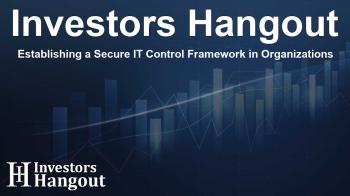Establishing a Secure IT Control Framework in Organizations

Establishing a Secure IT Control Framework in Organizations
Organizations face significant challenges in managing IT controls, particularly amidst increasing cybersecurity threats and evolving regulations. Many still lack a centralized IT controls register, which can expose them to security breaches and compliance failures. Recent insights from a well-known research firm highlight the critical need for a structured and risk-oriented approach to bolster oversight and resilience. Their new release, Build an Effective IT Controls Register, offers a comprehensive methodology for IT and risk leaders to align their IT controls with broader organizational objectives, implement protections, and support the safe adoption of technology.
Understanding the Current Landscape of IT Controls
As cyber threats grow more sophisticated, businesses find themselves navigating complex and often unstable environments with outdated IT control frameworks. Research indicates that weaknesses in these controls frequently result in expensive breaches, compliance shortfalls, and even severe repercussions for IT professionals. The imperative for organizations is to shift towards more effective management of their IT controls, mitigating risks before they escalate into serious issues.
The Rising Importance of IT Control Frameworks
Today, organizations are urged to develop a more robust understanding of their IT control landscapes. This involves not only recognizing the existing gaps but also implementing a proactive strategy to enhance these frameworks to adapt to new risk factors, particularly those introduced by cutting-edge technologies such as artificial intelligence.
A Comprehensive Methodology for Building IT Controls
To assist businesses in fortifying their control environments, the research group's blueprint presents a detailed, three-phase methodology. This approach is designed to be both structured and data-driven, ensuring it meets the evolving demands of the market. The objective is clear: to help organizations establish a resilient and effective IT controls register tailored to their unique challenges.
Phase 1: Identify Organizational Goals
The first step for IT leaders is to establish clear objectives for their IT controls that align with the business’s overall priorities. They must create a control taxonomy that ensures coherence across all IT processes and enables them to map current controls. This evaluation will help identify any deficiencies and provide insight into what adjustments are required.
Phase 2: Assess and Enhance Current Controls
Next, collaboration is essential. By working with governance and audit teams, IT leaders are positioned to critically evaluate the effectiveness of existing controls. Factors such as design quality, application practicality, user feedback, and audit results must be considered to ensure that any new or enhanced controls effectively address all identified risks.
Phase 3: Implement Monitoring and Reporting
The final phase involves establishing ongoing monitoring processes and robust reporting systems. This mechanism ensures that the controls remain operationally effective and responsive to emerging challenges. Ultimately, it creates a cohesive integration of the finalized controls register within the broader risk management framework.
Realizing the Benefits of a Strong IT Controls Register
By adhering to this structured approach, organizations can significantly boost their resilience and operational efficiency. The research firm strongly believes that this foundational methodology not only supports compliance with rapidly changing regulations but also enhances an organization’s ability to adopt governing, risk, and compliance tools effectively, paving the way for a more confident embrace of future technologies.
Frequently Asked Questions
Why is a centralized IT controls register important?
A centralized IT controls register helps organizations manage their governance, compliance, and risk management processes more effectively, reducing the likelihood of security breaches.
What are the phases in building an effective IT controls register?
The three phases are defining organizational goals, assessing current controls, and developing ongoing monitoring and reporting mechanisms.
How can organizations leverage emerging technologies safely?
By establishing a robust IT controls framework, organizations can better prepare for and manage risks associated with emerging technologies like AI.
What factors should be considered in assessing IT controls?
Key factors include design quality, implementation feasibility, user feedback, and audit findings to ensure comprehensive risk coverage.
How does a strong IT control framework affect operational efficiency?
A solid IT control framework streamlines processes, enhances compliance, and allows teams to focus on strategic initiatives instead of reactive risk management.
About The Author
Contact Dominic Sanders privately here. Or send an email with ATTN: Dominic Sanders as the subject to contact@investorshangout.com.
About Investors Hangout
Investors Hangout is a leading online stock forum for financial discussion and learning, offering a wide range of free tools and resources. It draws in traders of all levels, who exchange market knowledge, investigate trading tactics, and keep an eye on industry developments in real time. Featuring financial articles, stock message boards, quotes, charts, company profiles, and live news updates. Through cooperative learning and a wealth of informational resources, it helps users from novices creating their first portfolios to experts honing their techniques. Join Investors Hangout today: https://investorshangout.com/
The content of this article is based on factual, publicly available information and does not represent legal, financial, or investment advice. Investors Hangout does not offer financial advice, and the author is not a licensed financial advisor. Consult a qualified advisor before making any financial or investment decisions based on this article. This article should not be considered advice to purchase, sell, or hold any securities or other investments. If any of the material provided here is inaccurate, please contact us for corrections.

